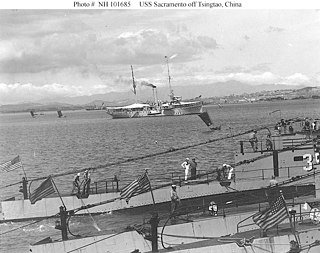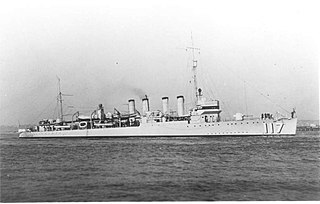
The second USS Sacramento (PG-19) was a gunboat in the United States Navy.

USS Rainbow (AS-7) was the only ship in the United States Navy by that name. The ship was originally converted to a distilling ship in 1898, and then converted again in 1917 to a submarine tender.

USS Dorsey (DD–117), reclassified DMS-1 on 19 November 1940, was a Wickes-class destroyer in the United States Navy during World War I. She was named for John Dorsey.

USS Galveston (C-17/PG-31/CL-19) was a Denver-class protected cruiser in the United States Navy during World War I. She was the first Navy ship named for the city of Galveston, Texas.

USS Raton (SS/SSR/AGSS-270), a Gato-class submarine, was a ship of the United States Navy named for the raton, a polynemoid fish inhabiting semitropical waters off the Pacific coast of the Americas.

USS Brill (SS-330), a Balao-class submarine, was a ship of the United States Navy in commission from 1944 to 1947. She was named for the brill, a European flatfish.

USS Bumper (SS-333), a Balao-class submarine, was a ship of the United States Navy named for the bumper, a small fish of the North and South Atlantic Ocean.

USS Sicard (DD-346/DM-21/AG-100) was a Clemson-class destroyer in the United States Navy following World War I. She was named for Montgomery Sicard.

The second USS Monterey was the sole Monterey-class monitor. Laid down by Union Iron Works, San Francisco, California, 20 December 1889, she was launched 28 April 1891, sponsored by Miss Kate C. Gunn. She was commissioned 13 February 1893.

USS Holland (AS-3) was a submarine tender that served in the United States Navy before and during World War II. Holland was launched by the Puget Sound Naval Shipyard, Bremerton, Washington on 12 April 1926, sponsored by Miss Elizabeth Saunders Chase, daughter of Admiral J. V. Chase, and commissioned on 1 June. Stationed at San Diego, California, tending submarine divisions there with periodic tours to Panama to service submarines based at the Canal Zone pre-World War two. Later serving in the Pacific theatre, by close of hostilities having given 55 instances of refit to submarines, provided repair and service to 20 surface craft and completed various jobs on shore installations.

USS Asheville, the lead ship in her class of two United States Navy gunboats, was the first ship of the United States Navy named for the city of Asheville, North Carolina. The ship was built at the Charleston Naval Shipyard of North Charleston, South Carolina, from her keel laying in June 1918, her launching in July 1918, and her commissioning in July 1920.

USS Isabel (SP-521), later PY-10, was a yacht in commission in the United States Navy as a destroyer from 1917 to 1920 and as a patrol yacht from 1921 to 1946.

USS Canopus (ID-4352-A/AS-9) was a submarine tender in the United States Navy, named for the star Canopus.

The first USS Pigeon (AM-47/ASR-6) was a Lapwing-class minesweeper of the United States Navy. She was later converted to a submarine rescue ship. She was named for the avian ambassador, the pigeon.

USS Beaver (AS-5) was a submarine tender which served in the United States Navy from 1918 to 1946.

USS Tulsa (PG-22), nicknamed the Galloping Ghost of the South China Coast, was an Asheville-class gunboat of the United States Navy that was in commission from 1923 to 1946. She was named after the city of Tulsa, Oklahoma, and the county seat of Tulsa County.

USS Marathon (PGM-89/PG-89) was an Asheville-class gunboat acquired by the U.S. Navy for the task of high speed patrolling in shallow waterways.

USS Samar (PG-41) was a gunboat of the United States Navy. She was initially built for the Spanish Navy, but was captured during the Spanish–American War and taken into service with the US Navy. Samar had two sister-ships which also served in the US Navy, USS Pampanga (PG-39) and USS Paragua.

The second USS Welch (PGM-93/PG-93) was a Asheville-class gunboat in the United States Navy during the Vietnam War.

HMS Wishart (D67) was a Modified W-class destroyer of the British Royal Navy that saw service in World War II. She spent most of her wartime career based at Gibraltar, engaged in convoy defence, but also served in various naval and military operations in the Mediterranean Sea.





















